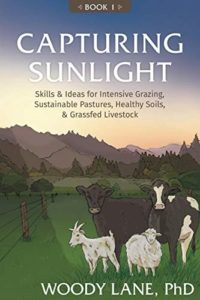Reviews of the book Capturing Sunlight, Book 1: Skills & Ideas for Intensive Grazing, Sustainable Pastures, Healthy Soils, & Grassfed Livestock
I’ve spent some quality quarantine time on our back porch reading through a truly engaging book on forage management written by a friend in Oregon. Most of the book is organized and written in a similar manner as Jim Gerrish’s books with short, informative and practical chapters focused on specific topics. Well organized sections arrange these topics into focused areas including grazing techniques, soils and fertilization, forage growth, forage quality and even a section addressing the science and business interface of grazing. My favorite topic (by far) was a thought provoking one that summarized a lecture by Dr Van Soest on the intake and digestion of fiber by the largest dinosaurs. It was a great chapter to read and allow the mind to wander over a cold beer. The last section is a self described textbook which covers intensively managed grazing systems. This 25+ page section justifies the purchase price and gives a fantastic introduction to managed grazing even covering the grazing wedge. The book is fully indexed and even has an appendix. Pick up a copy of this book. It’s producer friendly and can be picked up and read when there’s only a few free minutes in the evening. I’ve got a feeling I’ll read that dinosaur chapter quite a few more times in the coming weeks.
John Andrae Ph.D., Forage Specialist,
Clemson University, South Carolina
In the same way that forages capture sunlight and allow us to produce milk, meat, and wool, Woody Lane’s latest book, “Capturing Sunlight,” will enable even an experienced grazier to capture some knowledge and put it into practice. Lane uses a conversational tone and some humor that puts him right across the kitchen table to convey some hard science, experiences, and opinions of how to operate a grazing business. At the heart of it all is management-intensive grazing (MIG), which brings forage mass in line with animal mass.
The book’s collection of short essays make for easy and enjoyable reading. When finished, you won’t question the importance of stocking density, soil fertility, fencing location, forage quality, and the willingness to adapt on the fly. You’ll also read about the critical role that science plays and why science and scientists have sometimes fallen short in their evaluation of grazing systems. Finally, you’ll go on a couple of pasture walks and learn why those tall clumps of grass aren’t being eaten.
Lane’s passion for grazing is evident from the beginning of the book until the end. He’ll affirm what you thought you knew, make you learn what you didn’t know, and sometimes you might even want to question his opinion. Most importantly, he’ll make you think. Go ahead — read the book — you’ll be a better grazier for doing so.
Mike Rankin, Managing Editor, Hay & Forage Grower
Fort Atkinson, Wisconsin
As a very slow and deliberate reader, I’m about halfway through it, far enough to be able to say that it is a wonderful book. Though in truth it isn’t a topic that would normally engage me, I found myself fully engaged by the way you tell the story and relay the information. You have such a gift for conversational writing. Maybe the best example of it is — so far — is the chapter “Field of Dreams.” I can really picture everything you’re “showing” me. It is not easy to write so charmingly and fill your sentences with unforced energy and personality while also conveying a ton of information. Your ability to do so is truly impressive.
